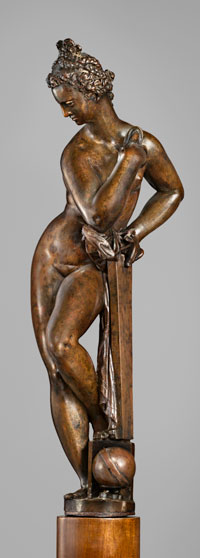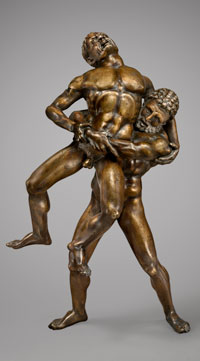Bronze meets tin at the Frick Collection

Simply sign up to the Life & Arts myFT Digest -- delivered directly to your inbox.
Some works of art are made to create a bravura public display; others are intended for private delectation, made on a scale that encourages close inspection and of a material that allows, even insists on their handling and the play of light. Few are more rewarding – or challenging – than the remarkable small-scale bronzes that offer such a tantalising glimpse into the intellectual life of the Renaissance.
The Frick Collection in New York has made a specialism of staging highly focused exhibitions of these works. Whether big monographic retrospectives or displays of superlative private collections, they allow the public the opportunity, previously afforded only to their privileged owners, of getting up close and seeing them outside a vitrine.
At the end of January, the museum will be host to the Renaissance and Baroque bronzes of Janine and J Tomilson Hill. Its core is an exceptional group of statuettes produced by the greatest of all mannerist masters, Giambologna, and his circle, and its 32 pieces extend from Renaissance Italy to embrace the Netherlandish, German and French bronze-casting traditions. What visitors will not see, however, is the extraordinary counterpoint of their setting in the Hills’ home against the titans of postwar painting and sculpture. If ever proof were needed that power and monumentality are not dependent on scale, it is here. These bronzes more than hold their own, even against great de Koonings, Bacons and Warhols.
In 1995, when the couple bought the first of their nine Warhols, most from the 1960s – “Campbell’s Soup Can (Beef Consommé)” – they also acquired their inaugural bronze: a Hubert Le Sueur “Venus” (c1640) that once belonged to Louis XIV.

The two are not obvious bedfellows, yet the Hills’ Manhattan apartment abounds in arresting juxtapositions and unexpected dialogues. Who would expect to find, say, de Kooning’s massive and lumpen dehumanised bronze “Clamdigger” confronting a large Bacchic fountain figure by Adriaen de Vries, its face distorted by an exuberantly compelling grotesque mask? On the top of a Louis XVI commode stands the earliest known cast of Giambologna’s elegant female personification of “Astronomy” (c1570), the curve of her voluptuous naked thigh playfully echoing the calligraphic chalk doodles of the Cy Twombly “Blackboard” behind. Under Warhol’s “Mao” sits Barthélemy Prieur’s “Lion Devouring a Doe” (c1583).
In the dining room, a row of six mostly heroic, muscular male nudes, some struggling in mortal combat, are silhouetted against Ed Ruscha’s epic, ominous “Seventeenth Century”. As Hill writes in his preface to the Frick catalogue, bronze “captures action, tension, emotion. It immortalises a moment.” Over the fireplace in the library is a Bacon Pope; inside a niche is the “Hercules and Antaeus” attributed to the 15th-century Florentine Maso Finiguerra, where the mouth of the vanquished Antaeus is “formed like the scream from a Pollaiuolo painting”, as Hill puts it. This is not a comment one could imagine being uttered by many of today’s billionaire buyers of Warhols.
Hill takes pains to point out that when he and his wife began buying postwar art, the “entry point” for a Warhol was 5-10 per cent of what it is now. Yet it has been a highly successful career on Wall Street that has funded his pursuit of quality (he is president and chief executive of Blackstone Alternative Asset Management, and a vice-chairman of the Blackstone Group). He is evidently the driving force behind the acquisitions but it is, he insists, “a total collaboration”. “I have not bought a single thing without talking through the idea with Janine, and us thinking how it fits into the collection,” he says.

What drew him to the rather rarefied world of bronze? He cites countless visits to the Metropolitan Museum of Art and to the Frick – he grew up a few blocks away on Fifth Avenue – and the fact that his mother, Dorothy, 96, is an abstract painter and sculptor in bronze. For Janine Hill, who grew up haunting the museums and galleries not of New York but of Paris, bronzes were familiar territory. Another factor was their friendship with the architect, designer and bronze collector Peter Marino. Hill also liked the fact that these small-scale works had always been the very private preserve of the connoisseur-collectors who acquired them for their studioli or studies: what could be more appropriate for a collection in a family home formed purely for the pleasure of its owners?
Perhaps part of this pleasure also lies in the challenges of this notoriously complex field. Few collectors could match the focus, steely rigour and exacting standards of Tom Hill. He has clearly enjoyed every opportunity to handle and compare different casts and comparable models, sometimes even taking a bronze to a museum or another collector’s house for a “play date”.
He praises the expertise of Pat Wengraf, who has been his adviser in putting together this collection, yet Hill himself also has the courage – and confidence – to rely on his own eye. “We have never been hung up about buying a bronze because we did not know who made it,” says Hill. This skill has paid off: a particular coup was the spirited “Nude Striding Warrior” that turned up in South America and was subsequently identified as being by Willem Danielsz van Tetrode, who had worked with Benvenuto Cellini in Florence and, after his return to the Netherlands, initiated a passion for collecting small bronzes in northern Europe.
Such tours de force as this and Riccio’s “Strigil Bearer” (c1515-20) are among the earliest examples here of the “multiples” – at first as few as two or three – that sculptors began to produce after they realised they could fabricate reusable piece-moulds for their sculptures, either of independent works or reductions of monumental pieces. This was commercially appealing, not least as a means of promoting a wider diffusion of their reputation and ideas. Warhol’s soup cans, self-portraits, Marilyns, Mao, Lenin and “Electric Chair” are perhaps not so very different after all.
‘Renaissance and Baroque Bronzes from the Hill Collection’, Frick Collection, New York, January 28-June 15 2014. frick.org
Comments